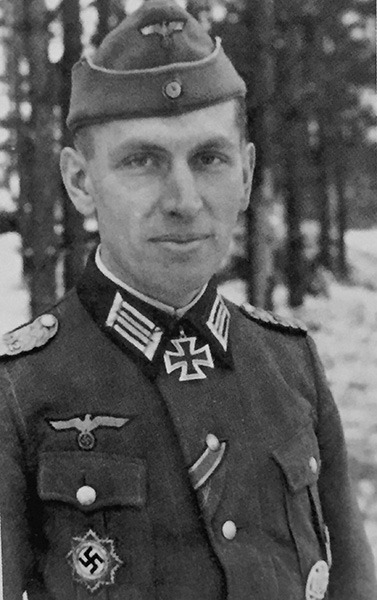Geisler, Rudolf
- Date of birth:
- March 29th, 1911 (Hennersdorf/Silesia, Germany)
- Date of death:
- April 13th, 1944 (Hauptverbandplatz Kowel, Kovel/Ukrain, Soviet Union)
- Buried on:
- German War Cemetery Pulawy
- Nationality:
- German (1933-1945, Third Reich)
Biography
Rudolf Geisler joined the Wehrmacht on 1 April 1930 as an officer candidate (Fahnenjunker) in Pioneer Battalion 8, where he was promoted to Leutnant (2nd Lieutenant) on 1 August 1933. He was transferred to Pioneer Battalion 1, where he was promoted to Oberleautnant (1st Lieutenant) on 1 October 1935. He then attended the Hanover War School (Kriegsschulen). In May 1938, he returned to active service with his first assignment being the company commander of 3/Pionier-Battalion 8.
After the Polish campaign he was promoted to Hauptmann (Captain) and took part in the western campaigns of 1940. On 1 August 1941 he became commander of Pionier-Battalion 662 where he was promoted to Major on 1 September 1942.
On June 3, 1943, he was awarded the German Cross in Gold. In November 1943 Major Geisler and his battalion succeeded in repelling several heavy Soviet attacks northwest of Newel. In recognition of his bravery and steadfastness during this time he would be awarded the Knight’s Cross. He received the medal on 7 December 1943. In February 1944 his battalion took part in the defense of Kovel, where it again proved itself, holding off the fierce Russian onslaught. It was during this defense he distinguished himself. Through a bold counterthrust that he led at the head of a small assault troop it was possible to throw back the Soviet forces that had already advanced as far as the railway station buildings. This in turn permitted the construction of a new defensive line, one from which every further onslaught by the Soviets was smashed. Rudolf Geisler was severely wounded in defense of Kovel on 11 April 1944 by fragments from a grenade during a Russian counter attack. He succumbed to his injury, a shrapnel wound in the pelvis, at a field hospital at Kovel on 13 April 1944, the same day Major Geisler would be awarded the Oak leafs to his Knights Cross.
The grave of Rudolf Geisler has not been found yet. His name has been added to the Memorial Book at the German War cemetery Pulawy.
Promotions:
September 1st, 1942: Major;
?: Oberstleutnant (posthumously).
Career:
August 1st, 1944: Kommandeur Pionier-Bataillon 662.
Do you have more information about this person? Inform us!
- Period:
- Second World War (1939-1945)
- Awarded on:
- September 30th, 1939
- Period:
- Second World War (1939-1945)
- Awarded on:
- October 1940
- Period:
- Second World War (1939-1945)
- Awarded on:
- August 13th, 1941
- Period:
- Second World War (1939-1945)
- Awarded on:
- August 22nd, 1942
- Period:
- Second World War (1939-1945)
- Awarded on:
- April 1943
- Period:
- Second World War (1939-1945)
- Rank:
- Major
- Unit:
- Kommandeur, Pionier-Bataillon 662, Heer
- Awarded on:
- June 3rd, 1943
- Period:
- Second World War (1939-1945)
- Rank:
- Major
- Unit:
- Kommandeur, Pionier-Bataillon 662, Heer
- Awarded on:
- December 7th, 1943
- Period:
- Second World War (1939-1945)
- Rank:
- Major
- Unit:
- Kommandeur, Pionier-Bataillon 662, Heer
- Awarded on:
- April 13th, 1944
455th Award.
Sources
- Photo 1: Steven Hesky
- - FELLGIEBEL, W.P., Elite of theThird Reich, Helion & Company Limited, Solihull, 2003.
- PATZWALL, K. & SCHERZER, V., Das Deutsche Kreuz 1941-1945, Verlag Klaus D. Patzwall, Norderstedt, 2001.
- THOMAS, FRANZ & WEGMANN, GÜNTER, Die Eichenlaubträger 1940-1945, Biblio-Verlag, 1997.
- Overlijdenskaart Wehrmacht










